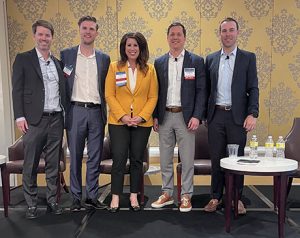CHARLOTTE, N.C. — Multifamily developers are pushing their chips in and aggressively looking for new development deals, especially for sites in and around high-growth markets in the Southeast. Michael Tubridy, senior managing director of Crescent Communities, said his firm isn’t leaving anything to chance and is looking to move quickly on development opportunities.
“We’re trying to get as many units on the ground today as possible, because tomorrow will be more expensive,” said Tubridy. “I like the chances of today’s cost environment a lot better than I like the unknown of where we’ll be a year from now or two years from now. Putting a premium on speed to market is something that we are much more focused on; it’s almost the only priority right now.”
Tubridy’s comments came during the development panel at InterFace Carolinas Multifamily 2022. The half-day event was held on April 14 at the Hilton Uptown Charlotte hotel and attracted more than 260 attendees from all facets of the multifamily industry in North Carolina and South Carolina. Michael Saclarides, director of Cushman & Wakefield’s Multifamily Advisory Group, moderated the discussion.
Crescent Communities is far from the only multifamily developer pursuing ground-up construction opportunities in earnest. In metro Charlotte alone, developers pulled permits for approximately 10,000 new multifamily units in 2021, which is about 25 percent more than the previous year, according to Northmarq research. In Raleigh-Durham, permits for future multifamily starts saw a 62 percent spike from 2020 to 2021.

Speakers from the development panel at InterFace Carolinas Multifamily included, from left, Michael Saclarides of Cushman & Wakefield (moderator); Michael Tubridy of Crescent Communities; Palmer McArthur of RangeWater Real Estate; Josh Glover of Greystar; and Mason Ellerbe of Abacus Capital.
The panelists agreed that frenetic future development activity in the Carolinas is a direct result of the “overwhelming” demand for new apartments, but also because it’s a mitigant to future cost risks. Inflation is soaring for construction materials as the producer price index (PPI) for construction materials rose 24 percent from March 2021 to March 2022, according to the U.S. Bureau of Labor Statistics.
“We are facing an unprecedented market event, not only with price escalation, but supply chain issues and labor shortages,” said Tubridy. “We don’t see that deescalating or even plateauing. We foresee construction costs are going to continue to rise, especially in the smaller Sun Belt markets that just aren’t built up to have enough capacity in the labor force to handle the volume that’s in the pipeline now. And we are seeing supply chain issues across pretty much all material types, and it’s something new every week.”
On top of fluctuating construction materials pricing, developers are also faced with rising debt costs. In response to rising inflation, the Federal Reserve raised the federal funds rate by 50 basis points at its May meeting, which is the biggest interest rate increase since 2000.
What’s helping buoy elevated costs is double-digit rent growth in today’s top apartment markets. Nationally, average effective rental rates were up 13.7 percent year-over-year in the first quarter, according to research from Lee & Associates. In Charlotte and Raleigh-Durham, that figure is closer to 20 percent.
The panelists said that migration patterns and supply/demand dynamics in the Carolinas are encouraging indicators for future rent growth, but it’s still unknown if rent growth is going to match the rise in construction costs moving forward. Palmer McArthur, managing director of development firm RangeWater Real Estate, said that looking back can be instructive on how to take calculated risks for multifamily deals.
“Going back 24 months and looking how deals turned out compared to what they were underwritten for, at the time they looked a lot worse on the cost side,” said McArthur. “But [those deals] actually ended up looking better than they did initially because values went up, too. Even though it was painful to get to that point, at the end of the day we had a good deal on our hands.”
Not all developers can compete for shovel-ready sites in and around high-growth markets like Charlotte and Raleigh-Durham, so speed to market isn’t always a plausible strategy. Mason Ellerbe, principal at Abacus Capital, said that his firm has to take alternative paths with the long game in mind.
“We’re looking for unentitled land; that’s one way we’re mitigating [rising costs],” said Ellerbe. “It also helps that we’re going to be in the design phase in the next 12 months, when most people think that volatility will occur and then settle back down a little bit.”
Nationally, one of the more popular alternative development options since the onset of the COVID-19 pandemic is build-to-rent (BTR) properties, which resemble single-family neighborhoods but are purposefully built for renters. Right now in Charlotte and Raleigh-Durham, BTR communities represent a fraction of the overall rental residential inventory.
“In Charlotte there are fewer than 10 dedicated BTR communities and you can say the same about Raleigh-Durham — you can find more in Myrtle Beach than you can here,” said John Currin, Northmarq’s senior vice president of investment sales, who moderated the conference’s BTR panel. “BTR communities represent only 0.1 percent of rental housing stock in Charlotte.”
Creighton Call, managing partner at Canvas Residential, said that the BTR movement has several headwinds to development, not the least of which are rising construction costs.

Speakers at the build-to-rent panel at InterFace Carolinas Multifamily Southeast included, from left, John Currin of Northmarq; Stewart Roulston of JPMorgan Chase; Marcie Williams of RKW Residential; Creighton Call of Canvas Residential; and John Gray of LennarSFR.
“It’s extremely challenging just from pure land competition with national homebuilders, which have had a lot of success over the last few years,” said Call. “Once you find a site, we have large utility challenges, especially as it relates to sewer and entitlements as timelines are running a lot longer than they used to.”
The panelists agreed that it behooves for-sale homebuilders to move into the BTR space, but right now there’s not much incentive since single-family housing is such a strong industry.
“Until homebuying slows, we’re just going to see a lot of new BTR supply,” said John Gray, president of LennarSFR, a division of Miami-based homebuilder Lennar. “Why would you be an apple farmer when you’ve grown oranges your entire life and orange prices are at an all-time high?”
— John Nelson


